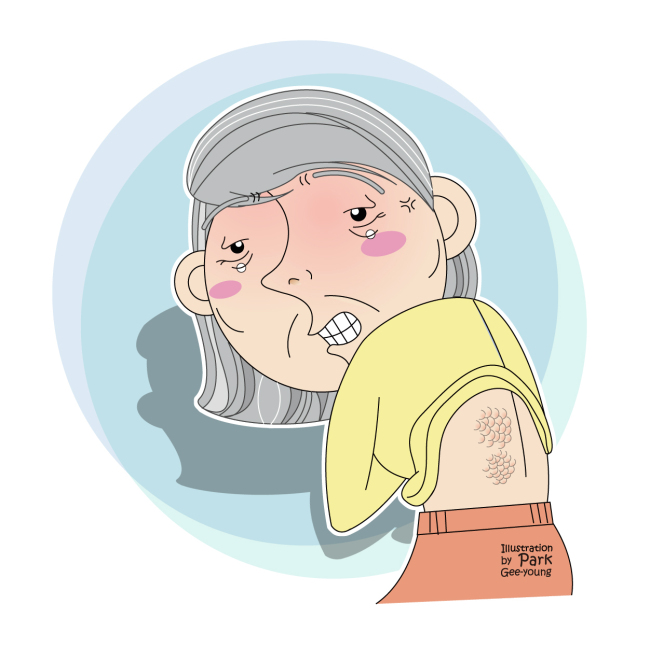An elderly lady in her early 60s came into the hospital. She had experienced sharp pain in her left breast for two to three days, together with cold symptoms. Previously, she had taken cold medicine and used heat patches from the local pharmacy to ease the pain. However, the pain gradually worsened and became so severe that she had difficulty breathing. After removing the heat patches the next day, she noticed small blisters on the skin which she thought were an allergic reaction to the patches and decided to see a doctor.
She was living with her son, daughter-in-law and 1-year-old grandchild, whom she looked after as the couple worked. Although she did not have regular health checks, she reported that she never had any illness.
Many elderly patients who come to the dermatology clinic with unusual symptoms such as these have shingles. Shingles is caused by a virus that produces small blisters on one side of the spine about the size of red beans.
She was living with her son, daughter-in-law and 1-year-old grandchild, whom she looked after as the couple worked. Although she did not have regular health checks, she reported that she never had any illness.
Many elderly patients who come to the dermatology clinic with unusual symptoms such as these have shingles. Shingles is caused by a virus that produces small blisters on one side of the spine about the size of red beans.

Most patients are curious about how they became infected with the virus. The virus that causes this disease ― Varicella-zoster virus ― is the same one that causes chicken pox. The virus remains in the spinal fluid after the chicken pox has been treated. It flares up when the immune system is weak or when the patient is suffering from another condition.
Shingles is characterized by the fact that it spreads through the nerves in the body. Nerves spread to the right or to the left from the spine; therefore, patients with shingles develop pain and blisters on one side of the body. Of the nerves, sensory nerves are more frequently affected than motor nerves.
Blisters and pain
The first symptom of this disease is severe pain on one side of the body, with sensory deficits. This can present itself as a headache, difficulty breathing, abdominal pain, numbness of the limbs and myalgia. At this point, there are no blisters and the patient will experience itchiness and pain. Often they experience muscle pain and visit clinics specifically for this or other internal diseases rather than a dermatologist. Within a few days the patient will develop blisters, which is often how it is diagnosed. After about three days, the blisters become mucky, and scabs form within a week.
Complications
This disease can manifest with various complications depending on the affected region. For example, if it pops up near the eyes, complications can arise with sight. When it affects the face and the ears, facial nerve palsy can occur. Shingles affecting the bladder can lead to problems urinating.
The motor nerves are affected in less than 5 percent of all patients, which can lead to motor nerve palsy and patients may not be able to lift up their arms and legs. The main complication of this disease is postherpetic neuralgia, which is lasting pain, even after the condition is treated.
Shingles often affects the elderly (aged 60 and above), AIDS patients, cancer patients and those receiving chemotherapy who have decreased systemic immunological function, leading to the recurrence of the virus. However, it can also occur in young people who are under stress or overworked.
Antiviral therapy
Various antiviral agents have been developed recently to treat shingles. However, as mentioned previously, this disease is caused by a virus and there are no medicines that can entirely eradicate it. The most important method of treatment is the administration of antivirals in the early stages to prevent the occurrence of neuralgia. Antivirals can be injected for approximately one week within 3-5 days of the occurrence of blisters. Analgesics can also be used together with the antivirals. However, the elderly or cancer patients who wait too late to receive treatment may experience persistent pain, even after treatment.
The pain differs depending on the patient, but it can last between one month and one year. In some patients, the pain can last for even longer. Antivirals are mostly excreted by the kidneys so the dose must be adjusted in patients with renal failure.
The disease is not transmitted by physical contact. However, those who have not previously had chicken pox, children or those who are hospitalized should not come into close contact with these patients as they may develop the disease.
Immunity is not developed after having shingles once and a patient may become affected by shingles again in later life. However, the rate of recurrence is very low at 0.1 to 1 percent.

By Yang Jun-mo
The author is a doctor at the Department of Dermatology at Samsung Medical Center and a professor of Sungkyunkwan University School of Medicine. ― Ed.
-
Articles by Korea Herald



![[Herald Interview] 'Amid aging population, Korea to invite more young professionals from overseas'](http://res.heraldm.com/phpwas/restmb_idxmake.php?idx=644&simg=/content/image/2024/04/24/20240424050844_0.jpg&u=20240424200058)






![[Hello India] Hyundai Motor vows to boost 'clean mobility' in India](http://res.heraldm.com/phpwas/restmb_idxmake.php?idx=644&simg=/content/image/2024/04/25/20240425050672_0.jpg&u=)








